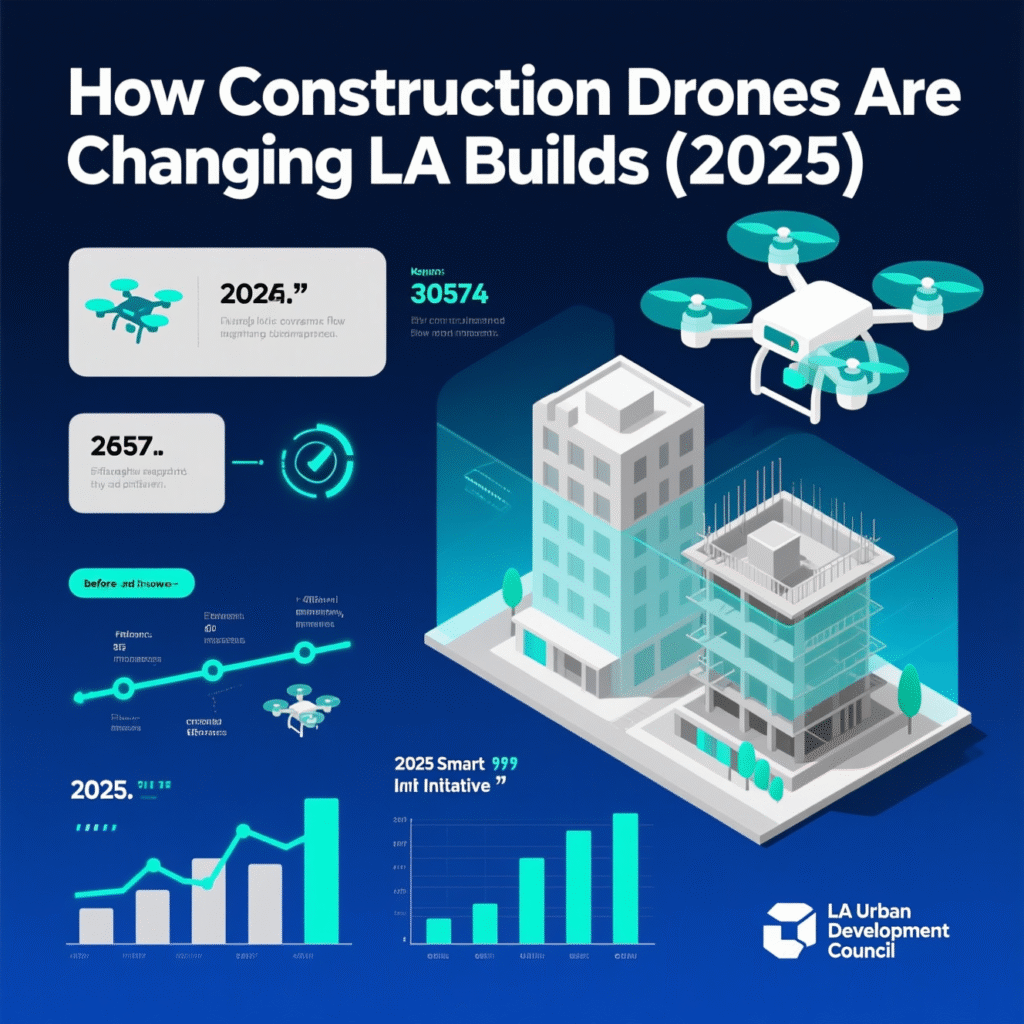Los Angeles has always been a hub for architectural innovation, from hillside modernist homes to sprawling commercial developments. In 2025, a new technology is transforming how these projects are planned, monitored, and executed: construction drones. Once seen as a futuristic concept, drones are now a critical part of the construction industry, reshaping the way builders, architects, and developers approach projects across LA.
Table of Contents
ToggleTable of Contents
This article explores how drones are changing the construction landscape in Los Angeles, why builders are adopting them, and what homeowners and developers should expect as drone technology becomes standard in the building process.
The Rise of Drones in LA’s Construction Industry
Over the past decade, construction in LA has become more complex. Urban density, strict zoning regulations, hillside terrains, and wildfire-prone areas all pose unique challenges. Traditional surveying methods, manual inspections, and on-site monitoring often slow down projects and increase costs.
Drones offer a solution. Equipped with high-resolution cameras, LiDAR sensors, and real-time data transmission, drones can quickly capture aerial views, create 3D models, and monitor site progress with greater accuracy than traditional methods. This efficiency is especially valuable in Los Angeles, where tight schedules, environmental considerations, and high labor costs are constant concerns.
Key Benefits of Construction Drones in LA Builds
Faster and More Accurate Surveys
Surveying a hillside property in the Hollywood Hills or a dense urban lot in Downtown LA can take weeks with traditional methods. Drones can map the terrain in hours, capturing topographic data and producing detailed 3D site models. This speeds up the design phase and reduces costly errors later.

Enhanced Project Monitoring
Developers and homeowners often struggle to track construction progress in real time. Drones provide regular aerial updates, allowing stakeholders to see exactly how a project is evolving. In LA, where many investors and homeowners may not live on-site, this remote visibility improves communication and accountability.
Improved Safety
Construction in Los Angeles often involves risky environments, from steep hillside builds to tall mid-rise projects. Drones reduce the need for workers to climb scaffolding or access unstable areas for inspections. This minimizes accidents and keeps safety at the forefront.
Cost Savings
By detecting issues earlier—such as grading problems, material shortages, or alignment errors—drones prevent costly rework. While the upfront cost of drone integration may seem high, the long-term savings in labor, time, and materials make it a smart investment for LA builders.
Better Design and Visualization
Architects in Los Angeles increasingly use drone data to create realistic 3D renderings of projects. Homeowners planning a Malibu cliffside retreat, for example, can see how their future home interacts with the terrain and views before breaking ground. This visualization helps secure permits and align expectations early.
Drone Applications in Different LA Build Types
Residential Homes and ADUs
For homeowners building a backyard ADU or custom residence, drones streamline the permitting process. Detailed aerial maps make it easier to demonstrate compliance with setback rules, grading codes, and drainage requirements.
Commercial Developments
Large-scale projects like mixed-use complexes in Downtown LA benefit from drones’ ability to track material deliveries, worker productivity, and construction timelines. Drone footage also helps attract investors by providing transparent progress updates.
Hillside and Coastal Builds
Los Angeles is famous for hillside mansions and coastal retreats. Drones are invaluable in these projects, where terrain challenges and soil stability must be carefully evaluated. By generating detailed slope analyses, drones support safer foundation planning and long-term stability.
Infrastructure and Public Projects
From freeway expansions to housing initiatives, public projects across LA rely on drones to meet deadlines and budgets. Drones help document compliance with California state building codes, environmental regulations, and sustainability goals.
Regulatory Considerations in Los Angeles
While drones provide immense benefits, their use is regulated by both federal and local laws. In Los Angeles, builders must comply with:
- FAA Part 107 regulations for commercial drone use.
- Local zoning and privacy rules that restrict drone flights over certain neighborhoods.
- Safety protocols ensuring drones do not interfere with air traffic, especially near LAX and regional airports.
Builders often partner with licensed drone operators to ensure compliance, which also provides liability protection.

The Future of Construction Drones in LA
In 2025, drones are becoming more sophisticated. AI-powered drones can now detect structural issues automatically, track material usage, and even predict potential delays. Integration with BIM (Building Information Modeling) allows for seamless updates between drone data and digital blueprints, ensuring that projects remain aligned with design intent.
Looking ahead, experts predict drones will be used not only for surveying and monitoring but also for tasks like autonomous material delivery, site security, and environmental analysis. In Los Angeles, where climate adaptation and wildfire safety are major concerns, drones will play a growing role in monitoring vegetation, detecting fire risks, and ensuring new builds meet California’s evolving environmental standards.
Final Thoughts
Construction drones are no longer an optional add-on—they are becoming a necessity for Los Angeles builds in 2025. They save time, improve accuracy, enhance safety, and offer transparency for homeowners, developers, and investors. Whether you’re constructing a modern hillside home, a luxury Malibu estate, or a large-scale urban project, drones provide a competitive edge in LA’s fast-paced construction market.
As the technology evolves, drones will only become more integral to California’s construction future, blending innovation with efficiency to meet the demands of the state’s growing housing and infrastructure needs.


